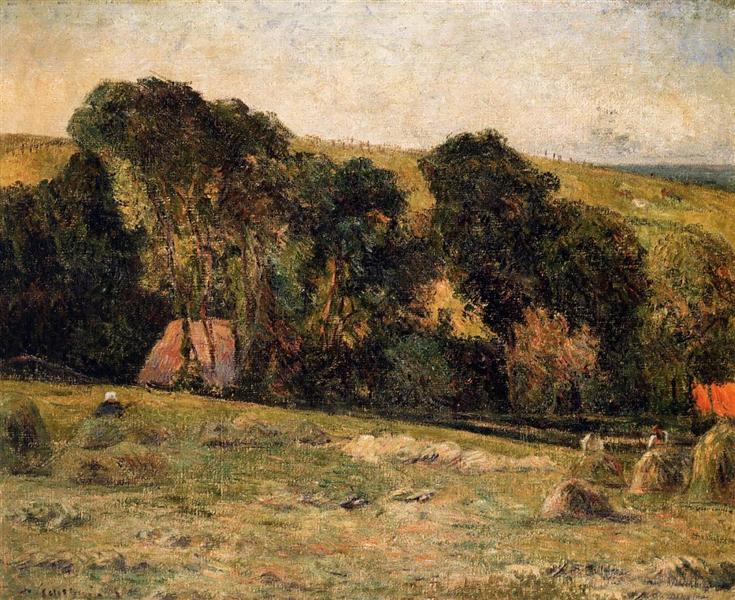Description
Paul Gauguin's Haymaking near Dieppe (1885) falls within a significant period of his artistic production, a time when the influence of Impressionism was flowing and Post-Impressionism was brewing. Set on the Normandy coast, the painting captures a vibrant rural scene depicting farm workers engaged in the task of harvesting hay, an activity deeply rooted in French agrarian life. This concern with rural life and its representation is a recurring inclination in Gauguin's work, framed in a style that, although it may be reminiscent of Impressionism, already begins to hint at his later evolution towards the synthesis of bolder forms and colors.
In terms of composition, the painting is carefully balanced. On the left, a group of workers are engaged in harvesting, symbolizing human effort in the daily struggle with nature. The figures, while not overly detailed, possess a sense of activity and vitality that is reflected in their poses and the direction in which they work. The proximity of the figures to the horizon line creates a sense of immersion in the scene, inviting the viewer to be part of the communal labor.
Colour plays a crucial role in this work. Gauguin uses a rich, saturated palette that evokes sunlight and the freshness of summer. The vibrant greens of the landscape contrast with the earthy tones used for the characters’ clothing; this colour choice not only establishes a harmonious visual dialogue, but also gives the painting a sensorial dimension that indirectly evokes the rural environment. The shadows and the way the light unfolds across the fields are a clear reference to Gauguin’s technical skill in manipulating colour and light, coupled with his desire to convey moods through the intensity of his palette.
Also noteworthy is the context in which this work was created. In 1885, Gauguin was still a relatively little-known artist, combining painting with his professional life as a stockbroker. However, he was already beginning to distance himself from traditional representation in favour of a more personal and symbolic search for the emotional truth of his surroundings. Although Haymaking near Dieppe is not as laden with explicit symbolism as his later works, it anticipates his future shift towards more emotional narrative and greater abstraction, where form and colour take on a force independent of the object depicted.
In terms of parallels, this work can be related to other creations from the same period that reflect everyday life and the human connection to the countryside. Paintings by Claude Monet or Camille Pissarro, for example, share this vision of agricultural work, but with a stronger focus on changing light and atmosphere. Gauguin, although influenced by these masters, brings his own uniqueness to the scene through a more intentional approach to colour and composition, tending towards a style that would challenge the traditional perception of landscape.
"Haymaking near Dieppe" is a manifestation of Paul Gauguin's artistic evolution, capturing an instant in time that fuses human activity and nature in a harmonious dialogue. The work, in its simplicity and strong expressiveness, prefigures his imminent transformation towards symbolism, consolidating Gauguin as a significant bridge between impressionism and the avant-garde of the 20th century. This canvas is not only a testimony of rural life, but a prelude to an artistic journey that will change the history of art.
KUADROS ©, a famous painting on your wall.
Hand-made oil painting reproductions, with the quality of professional artists and the distinctive seal of KUADROS ©.
Painting reproduction service with satisfaction guarantee. If you are not completely satisfied with the replica of your painting, we will refund 100% of your money.

